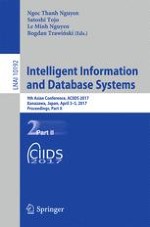The two-volume set LNAI 10191 and 10192 constitutes the refereed proceedings of the 9th Asian Conference on Intelligent Information and Database Systems, ACIIDS 2017, held in Kanazawa, Japan, in April 2017. The total of 152 full papers accepted for publication in these proceedings was carefully reviewed and selected from 420 submissions.
They were organized in topical sections named: Knowledge Engineering and Semantic Web; Social Networks and Recommender Systems; Text Processing and Information Retrieval; Intelligent Database Systems; Intelligent Information Systems; Decision Support and Control Systems; Machine Learning and Data Mining; Computer Vision Techniques; Advanced Data Mining Techniques and Applications; Intelligent and Context Systems; Multiple Model Approach to Machine Learning; Applications of Data Science; Artificial Intelligence Applications for E-services; Automated Reasoning and Proving Techniques with Applications in Intelligent Systems; Collective Intelligence for Service Innovation, Technology Opportunity, E-Learning and Fuzzy Intelligent Systems; Intelligent Computer Vision Systems and Applications; Intelligent Data Analysis, Applications and Technologies for Internet of Things; Intelligent Algorithms and Brain Functions; Intelligent Systems and Algorithms in Information Sciences; IT in Biomedicine; Intelligent Technologies in the Smart Cities in the 21st Century; Analysis of Image, Video and Motion Data in Life Sciences; Modern Applications of Machine Learning for Actionable Knowledge Extraction; Mathematics of Decision Sciences and Information Science; Scalable Data Analysis in Bioinformatics and Biomedical Informatics; and Technological Perspective of Agile Transformation in IT organizations.
